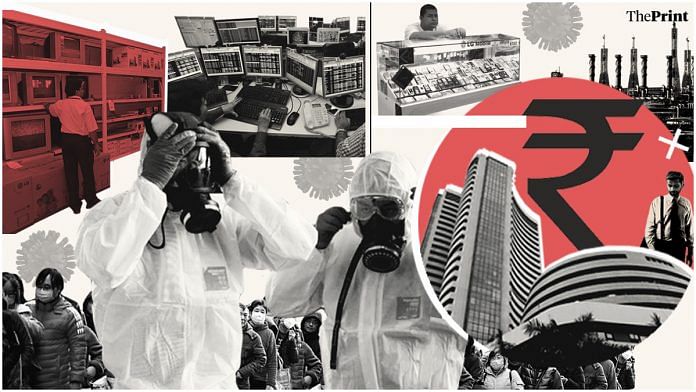The novel coronavirus or COVID-19, which has claimed 2,800 lives in China and affected more than 80,000 people worldwide, is taking a toll on the global economy. India’s automobile and pharma sectors, which depend on China for raw materials, are already feeling the pinch. PM Narendra Modi’s government said it is keeping a close watch on the likely impact of the virus on the Indian economy.
ThePrint asks: Is Indian economy equipped to deal with the global disruption caused by coronavirus?
India needs structural reforms to derisk its supply chains to counter disruptions like coronavirus
 Chandrajit Banerjee
Chandrajit Banerjee
Director General at Confederation of Indian Industry (CII)
The coronavirus episode is certainly impacting Indian industry because it has disrupted the manufacturing capacity of the largest manufacturer and exporter in the world — China. Its spread to other parts of the world is a concern because it is likely to lead to disruptions to other geographies as well. For Indian industry that has a large domestic market, local supply chains and a smaller engagement in global value chains, it is proving to be less of a disruption.
The challenges are so far limited to a few specific sectors that have strong outward connect. We have to look at how long and how wide the coronavirus will live and according to the IMF, it should be contained within a few weeks. The takeaway from the disaster is that India needs to derisk its supply chains, which is possible with further movement on ease and cost of doing business and continued structural reforms. India needs to move rapidly towards becoming a global manufacturing hub for most items.
I think the Indian government has been proactive so far and has done detailed consultation with industry and other stakeholders to assess impact and also look at opportunities arising.
India has always wanted to displace some of value chain production from China. This is the time to pursue it
 Rajat Kathuria
Rajat Kathuria
Director and chief executive, ICRIER
There could be a short-term disruption as well as long term-benefit due to the coronavirus outbreak. The short-term disruption is linked to the global supply chain from China. Pharmaceuticals and electronic components are examples where the disruption is expected. Now the question is how quickly we can find a substitute in the supply chain in case of a disruption.
For electronic components, the problem is that India can’t approach other countries like Vietnam and Thailand because their value chains are also linked to China. If we go to Korea and Japan, the costs will make the appliances uneconomical.
But in the long-term, it is an opportunity for India to start displacing some of the value chain production from China. We have always wanted to do that. As China became a stronger economy, the industries moved out to Vietnam, Bangladesh, Indonesia, but India attracted very few and was not able to benefit from China’s development and rise in per capita income. This is another opportunity to begin afresh. India needs to address its disabilities, especially at a time when it is aiming for becoming a $1trillion-export economy. India cannot become a $5-trillion economy without first becoming an export economy, for which it will have to attract investments.
Some of India’s export incentives may not be compatible with multilateral conditionalities. India needs to look at alternative ways to attract investments. So, the government’s reduction of corporate taxes is a good step in this direction. We will have to calibrate subsidies that are not compatible with WTO to production-linked incentives that are compatible with our WTO commitments.
India couldn’t capitalise on US-China trade war. But with coronavirus-left vacuum, India has another opportunity
 Nirupama Soundararajan
Nirupama Soundararajan
Senior Fellow & Head of Research, Pahle India Foundation
It would be naive to think that the coronavirus will have no impact on the global economy. The first sector to be visibly hit was tourism. With time, the economic impact of the virus has only worsened. Global value chains have been disrupted and the outbreak will cause an adverse impact on both manufacturing and on exports. Countries that are heavily dependent on Chinese manufacturing capabilities are already feeling the pinch. This is temporary, but it is enough to cause a significant dip in the region’s output and, therefore, global GDP.
For India, the impact of the coronavirus could go both ways. Exports to India will slow down. Sourcing raw materials will become difficult, possibly driving up the prices of many commodities; but it need not stop here.
India was not able to capitalise on the US-China trade war to capture exiting manufacturing business. This time, India has another opportunity. The pandemic has created a huge vacuum in the western world for manufacturing inputs. This may be a good time for India to attempt to fill that vacuum and recapture many lost markets.
It could be a time for India to regain its lost momentum in exports. It could be a time for Make in India to shine. Opportunities abound, but for India to be able to capitalise on it, credit has to pick up. If banks don’t start lending, this will be another lost opportunity in a long list of many.
India facing sluggish growth, does not have manufacturing capacity to fill up export gap created by China
 Aashita Dawer
Aashita Dawer
Associate Professor (Economics) at O.P. Jindal Global University
The coronavirus has had a huge impact on exports from China. It is widely claimed that India could increase its exports and fill the gap that has been created by China. However, India itself is facing sluggish growth and does not have manufacturing capacity to bump up exports. Moreover, India’s own imports from China stand at 18 per cent of its total imports. Most of the imported items include electrical machinery, organic chemicals, nuclear reactors and allied machinery and iron and steel. Since electrical parts and chemicals are the main raw materials for electronics and drugs, the prices of these are expected to go up in the domestic market.
India is one of the major producers of pharmaceutical drugs, which will be affected due to unavailability of the raw material from China. Domestically, Indian economy is going to face high inflation with even slower economic growth. So, India will not be able to enhance global exports and would rather face the problem in its domestic economy as well.
Also read: Homoeopathy for coronavirus: Is AYUSH commitment to alt meds healthy or promoting quackery?
By Unnati Sharma, journalist at ThePrint




We should come out of Hindu-Muslim game and focus on economy and opportunities for all
As always, India is behind and slow to capitalize on opportunities available to it. After ignoring and letting industries where India had a strong historical reputation (the Europeans came to India to trade in fabrics and clothing in case anyone remembers these days) to throw all of it’s eggs in the IT and ITES basket, we are now at a stage where shoppers at US and Canadian clothing chains ask sales staff if they could show them clothing and accessories that are “not made in China.” It is not that there is a hatred for China, but shoppers are frightened that even the clothes that they buy could be infected by the Coronavirus. Guess where the non Chinese replacements will come from? Bangladesh, Vietnam, Thailand, Indonesia etc. There was a time when from cheap clothing to the most premium semi custom clothing that you could buy, had a 50-50 chance of being made in India.
Perhaps, this will be a wake up and smell the coffee moment for Indian industry. The one refrain that you will hear at any business event in North America, Europe or the Far East is always how, despite having so much talent, India always seems to manage to bungle things up. Time to use that talent along with both tradition and newer industrial trends to strengthen the economy on the heels of the Coronavirus outbreak. Tighten your collective belt, India! There’s business to be done!
What is likely is that the spinmeisters will ascribe poor economic performance hereafter to Covid 19. In the years before President Trump started his trade war, there was no reason for India not to benefit from healthy global growth, including in merchandise trade. Small countries like Vietnam and Bangladesh made good use of that tailwind. 2. China’s manufacturing is 27% of GDP, ours is 16%. On a base that is almost four and a half times larger for them. That should give a sense of how daunting a task it is for Indian industry to replace China’s in the global economy. Quite apart from the fact that the world’s Value Chains are centred around China, almost completely bypassing India. 3. The government needs to do a far more stellar job of helming the economy than it has managed so far.